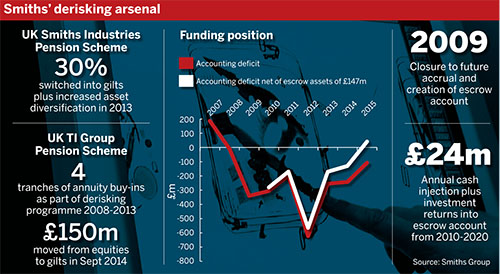Technology and engineering conglomerate Smiths Group has reported a significant improvement in the funding position of its defined benefit pension schemes after pursuing a stringent eight-year derisking campaign.
The global technology company – which provides products and services in areas including medical, rail, aerospace and weapons detection – last week reported its lowest net accounting deficit since 2008 having closed the gap between assets and liabilities by more than half, to £108m at the end of July from £242m 12 months earlier.
FTSE 100 DB schemes flooded into bonds in 2014 in a drive to derisk, but persistent deficits are forcing many schemes to seek risk reduction via growth-seeking assets. However, Smiths has now reached a position where its schemes are no longer dragging back the group's performance.
Philip Bowman, Smiths’ outgoing chief executive, said the 2007 sale of the group’s aerospace division, the global financial crisis and negative bond yields had combined to drive up the group’s net pension deficit.
Bowman said preliminary results from the schemes’ latest actuarial valuation recorded a technical provisions deficit of £147m for the Smiths Industries Pension Scheme taking into account the group’s escrow account.
What we’ve been seeking to do is progressively get to a stage where these plans can ultimately be wound up
Philip Bowman, outgoing chief executive officer, Smiths Group
“That figure at its peak was well over £1bn of deficit for that one scheme,” said Bowman. “That’s a very, very significant change.”
Bowman said that an enormous amount of management time and company cash flow had been channelled into reducing the scheme’s deficit and securing liabilities.
“After eight years of this we have finally got to a position where the pension funds are no longer a significant impediment to changing the [group] portfolio,” said Bowman.
“It’s taken a lot of time and a lot of money.”
Derisking marathon
Smiths administers two UK DB schemes – Smiths Industries Pension Scheme and the TI Group Pension Scheme – which closed to future accrual in November 2009, generating curtailment and past-service gains of £91m.
Since 2008 Smiths has made use of several instruments in the derisking toolkit.
Smiths' key moves
Closure of pension schemes to future accruals in 2009
Achieved curtailment and past service gains totalling £91m between 2008 and 2015
Establishment of escrow account following 2009 valuation
£24m annual cash injection plus investment returns into escrow account from 2010-2020
UK: Smiths Industries Pension Scheme
March 2013: 20% of assets switched to index-linked gilts
July 2013: 30% gilts; increased asset diversification
UK: TI Group Pension Scheme
2008-2013: Asset derisking with annuity buy-in programme in four tranches
Since Sept 2013 all pensioners have been insured: £871m of annuities
Further asset derisking in Sept 2014: £150m moved from equities to gilts
Ongoing £2m per month derisking assets to gilts
Bowman said the work had to be conducted over a significant length of time because of the sheer scale of liabilities built up across the membership.
“What we’ve been seeking to do is progressively get to a stage where these plans can ultimately be wound up,” he said.
Legacy burden
Nine in 10 members of the group’s schemes are no longer affiliated with Smiths group.
“These are businesses Smiths sold – before the time I got here, probably over the previous 20 years – but they retain their pension liabilities and that’s really the genesis of the major problem that we’ve had today,” said Bowman.
Lynda Whitney, partner at consultancy Aon Hewitt, said legacy liabilities were common for very large pension schemes, often brought about by the migration of divisions overseas and merger and acquisition activity.
“It’s really going in with an open mind to say ‘Which of the liability management actions can I take?’,” said Whitney.
“‘Can I do [pensions increase exchange], [enhanced transfer value], can I do exercises to manage the liabilities – where am I in terms of the risks that I’m taking with that scheme?’”
Whitney said the governance burden of legacy schemes was an added strain on management time and sponsor balance sheets.
“If it’s a small legacy plan and reasonably well funded, actually buying it out and winding it up is the best way to get rid of it,” said Whitney.
“In other plans you might be better [off] doing a scheme merger.”
Commercial conversations
Anne-Marie Winton, partner at law firm Arc Pensions Law, said trustees needed to be prepared to have “commercial conversations” with scheme sponsors about the time horizon for tackling legacy liabilities.
“Sometimes trustees think it’s not their role,” said Winton.
“[Trustees] could be more proactive by asking, ‘How long do you want these liabilities to run on for?’”














